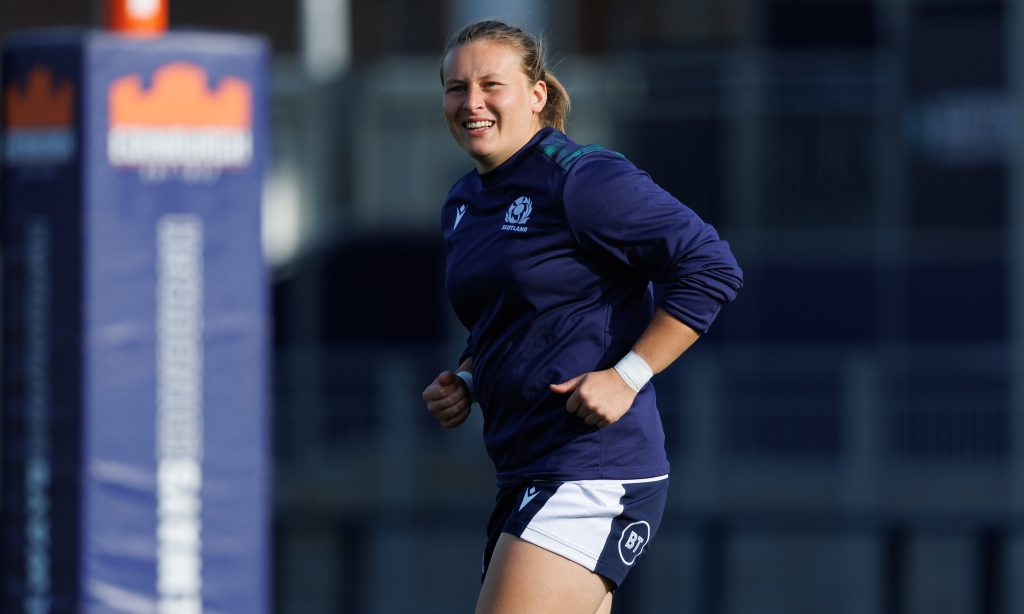
When she earned her 50th Scotland cap during the Six Nations in 2022, Sarah Law reflected that there had been many “highs and lows” in her stellar rugby career to that date.
Amongst the highs had been crucial winning kicks to help Scotland defeat Wales in the Six Nations in 2017 and to beat Ireland in the Rugby World Cup qualifiers in 2021.
The lows up to that point included a number of injury lay-offs, most notably being out for 11 months with a complex ankle issue between 2018 and 2019.
Sarah, who started her rugby at local club Penicuik and now plays for Sale Sharks in the English top flight, has always been a battler though and she had overcome those lows to get Scotland to their first World Cup in 12 years and, soon after, make the half century mark mentioned.
However, as preparations for the World Cup in New Zealand late in 2022 began after the Six Nations that year, scrum-half turned stand-off Law was about to face up to one of her biggest battles.
Around two years ago, Sarah was diagnosed with Axial Spondyloarthritis, also known as axial SpA, following an MRI scan to look at what were presumed to be rugby injuries.
It is a painful, progressive form of inflammatory arthritis. It mainly affects the spine, but can also affect other joints, tendons and ligaments and has to be managed in the long-term.
Symptoms are many and varied, but include onset of back pain and stiffness over weeks or months, early morning stiffness and pain, feeling better after exercise and worse after rest, fatigue and tiredness and feeling feverish and experiencing night sweats.
“It was obviously a real shock and when the medic told me what it was and it took some time to get my head around it because, I’ll be honest, I had never heard of it before,” Sarah, now 29 and with 53 Scotland caps to her name, explained.
“I was preparing for the World Cup, professional contracts with Scotland were coming into view and suddenly I had this to deal with all of this and it knocked me for six really.
“One of my biggest worries was my rugby career. The sport has been my life for as long as I can remember and I was concerned that it might be taken away from me right away.
“When I told the doctors the level I played at I was nervous at the thought of hearing I’d have to stop and, while people with the condition can’t always play contact sports, because of my levels of fitness I was told I could continue if it was all carefully managed and monitored.
“I tried to learn as much as I could as soon as possible and the doctors started to explain how it could be managed.
“I spoke to various experts in the field, as well as the medical teams with Scotland and Sale, and then started to experiment regarding which medication and such like would work best for me.
“We tried lots of anti-inflammatories at first and none of them made a difference and then there was a series of other things that we tried, but I had allergic reactions to some of those.
“Eventually I started to take biologic medication via self-injection. I have to do that every two weeks and it seems to be making a difference now, fingers crossed.
“Self-injection is fine now and I am used to it, but starting off with something like that is hard and definitely takes some getting used to.”
As mentioned, in the early months post-diagnosis, Sarah was preparing for the biggest moment in her rugby career, the World Cup.
“The build up to that was definitely a different one than I had expected because of this extra news,” the applied maths graduate explained.
“It felt so tough because we had built up for a decade to get to that point and playing rugby at the top level and all I wanted to focus on was my rugby, but I couldn’t.
“I had this news swirling around my head and that made the pre-World Cup camps pretty hard at times, but I must thank the Scotland physios who had been with me during the MRI scan leading up to the diagnosis and were playing a really active role in trying to find the best ways for me to manage the condition at the time.
“Their help put my mind at ease at the time along with my parents, sister, team mates and close friends who have always been there for me, but it was hard to focus solely on rugby.”
Sarah’s first competitive match of rugby since the diagnosis was at the World Cup in New Zealand when Scotland took on Australia in the pool phase.
She came off the bench in that one, but at the time she was still getting used to the medication and was feeling ill quite a lot of the time and suffering from morning sickness.
“I didn’t play as much as I’d have hoped in the World Cup because of everything that was going on, but I look back now and I am proud of myself that I got out there and pleased that I was able to play my part in a World Cup game,” she continued.
“I was still able to do the thing that I loved playing rugby, even if it was on slightly newer terms.
“When I came back from the World Cup the first batch of professional contracts were announced by Scottish Rugby and I was in there and so from then on it was about getting my head down at Sale while working out a plan to manage the condition week to week around more regular training and matches.
“From then [late 2022] to now nearly two seasons later I am still always learning. Like any condition like this there are good days and there are bad days and a lot of it is trial and error.
“I have had to adapt to the bad days and try to make them as bearable as I can, but sometimes it just means that unfortunately I can’t train.
“The coaches and the S & C coaches down here at Sale have been excellent, constantly checking in with me and modifying things if we have to and enjoying the ‘normal’ days when we can.”
This season Sarah does not have a Scottish Rugby contract, but she has still played as regularly as she has been able to for Sale in the PWR while she works remotely for the Scottish Government as an operational research analyst.
“It has been a strange two years really and not the two years I maybe envisaged since the diagnosis, but I am feeling better about things now and am ready to keep managing the issue as best as I can as I move forward.
“I wanted to tell my story because May 4 was World Ankylosing Spondylitis (AS) Day, an annual day dedicated to people living with Axial Spondyloarthritis.
“This whole month has been used to try and make people more aware of what is quite a complex condition and if I can shed some light on it to others then it is good to know that I can help.”
For more information, visit the National Axial Spondyloarthritis Society (NASS) website via nass.co.uk
